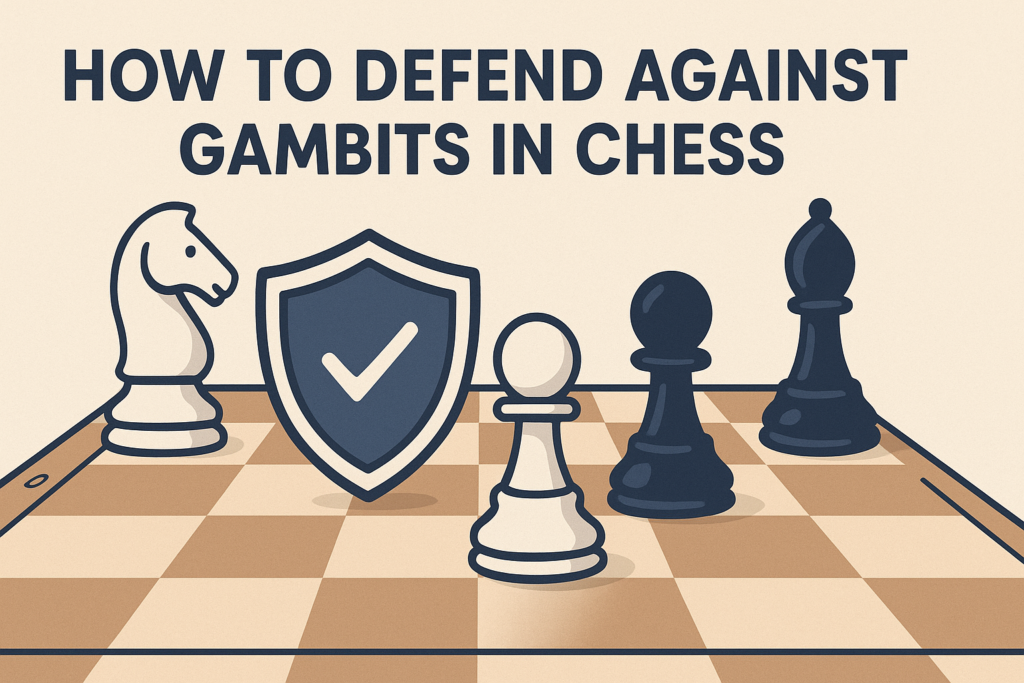Discover essential methods to refute gambits in chess: accept or decline them wisely, master Morra and Najdorf Poisoned Pawn defenses, and employ modern counterplay principles.
Introduction
The late Senior American Master Ken Smith, who passed away in February 1999, was a well-known advocate of gambits in chess. A notable exponent of the Morra Gambit against the Sicilian (1. e4 c5 2. d4 cxd4 3. c3), this opening continues to be referred to by some American players as the Smith-Morra Gambit.
Smith strongly encouraged players, particularly those in the earlier stages of development, to adopt a repertoire that included gambits, at least temporarily. His belief was that gambit play offers invaluable training in both attack and defense. Moreover, playing a gambit introduces a heightened sense of urgency. Being a pawn down requires evaluating every move with critical care and playing with maximum energy and precision. Without such effort, the game is likely to slip away. According to Smith, this sense of urgency is what provides the greatest benefit in a player’s long-term development.
He articulated this philosophy even more forcefully on his website, emphasizing a staged approach to mastering the openings:
STUDY AND MASTERY OF THE OPENINGS COME IN THIS ORDER:
A. Forcing Openings and Defenses (for minor/intermediate players, USCF Classes D/C)
B. Basic Opening Systems (for major/county players, USCF Classes C/B)
C. Add Gambits (for county players, Class A and above)
D. Sharp critical lines, the so-called “long variations”
E. Evolution to closed lines, if compatible with the player’s style
Further remarks directed at Class A players made his stance even clearer:
“Now is the time the boys will be separated from the men. It is the biggest decision you must be willing to make in your chess career. YOU MUST ADD GAMBITS TO YOUR OPENING SYSTEM (Note: I said ADD — NOT GIVE UP your basic system). You must play them, win with them, and lose with them. There is no substitute. Being a pawn down, you will have to dig into each position on each move. You will learn to use that extra space and tempo. You will develop that ‘killer instinct’ and learn to handle open positions — being ready when that closed position will surely become open. Those that cannot stand to lose games and rating points because they are converting to gambit play ARE HOPELESS in my book. Do not cry with them when they are on ‘that chess hill they can’t climb,’ and do not feel sorry when they start slipping backward. For with stubbornness and cowardice, they did not play gambits and dug their own chess graves!”
While this position may appear somewhat absolutist—since, after all, many paths can lead to mastery—it remains undeniable that every serious player should understand both how to play and how to counter gambits.
A prime example of gambit dynamics can be found in the following classic encounter:
By move 9, White has achieved full development. Although Black appears stable for the moment, the gambit has succeeded in creating dynamic play. White eventually went on to win in 54 moves.
Principles of Gambit Play
Several foundational principles underpin successful gambit play:
Principle 1: A gambit involves sacrificing a pawn in exchange for benefits such as quicker development, stronger central control, or both.
A clear illustration of this principle is the Danish Gambit: 1.e4 e5 2.d4 exd4 3.c3 dxc3 4.Bc4 cxb2 5.Bxb2
With the investment of two pawns, White has already developed two pieces and enjoys superior central control. The bishops are ideally placed to exert pressure on the center and kingside, and the open lines provide attacking avenues. The question arises: are two pawns a fair price for this?
It has often been said that three tempi are roughly equal to a pawn. By this valuation, White is only slightly behind in material and activity. However, development shouldn’t be judged merely by the number of pieces moved; what matters is the number of moves remaining to complete full development. Gambiteers often force the opponent to waste time reorganizing, giving themselves valuable initiative.
This concept becomes even more apparent in the Morra Gambit:
1.e4 c5 2.d4 cxd4 3.c3 dxc3 4.Nc3
On paper, Black appears to have a simple route: develop a piece and sit on the extra pawn. But things aren’t that straightforward.
4…Nc6
Even after this natural move, Black struggles to develop comfortably. White can bring out both bishops without further pawn moves, while Black must first make two pawn moves to do the same. Moreover, early development can result in tactical blows:
5.Nf3 d6 6.Bc4 Nf6? 7.e5! +/
For example:
7…Nxe5?? 8.Nxe5 dxe5 9.Bxf7+ or
7…dxe5? 8.Qxd8+ Nxd8 9.Nb5, with strong attacking prospects.
A return to the Danish Gambit further illustrates the principles of initiative and momentum:
“Richard Hall, a 51-year-old solicitor specializing in licensing law, has won the British Correspondence Chess Championship. He receives a £200 prize, the title of British CC Champion until the next championship, and the British Master title for life.” – Reg Gillman, British Chess Magazine
Consider this variation of the Danish Gambit:
A more powerful continuation than 10.0-0 Na5 as in Csom–Barczay, Hungary 1967.
This sequence breaks down Black’s defensive coordination:
Principle 2. The Best Way to Refute a Gambit Is to Accept It (Steinitz)
One of the earliest lessons taught to juniors is the classic advice:
Don’t snatch pawns in the opening, it’s not worth falling behind in development.
That guidance serves its purpose, especially as it shifts focus toward the crucial concept of development.
But perhaps it should be rephrased to something more refined:
Don’t snatch material in the opening, but the destruction of central pawns is another matter entirely.
After all, the opening phase of the game has two main goals: development and central control. With that in mind, capturing central pawns becomes not only acceptable but encouraged.
At the club level, it’s surprisingly common to see players declining gambits, sometimes even doing so “on principle.” But there is no principle in chess that says one must refuse free pawns. In fact, quite the opposite: there is established wisdom, notably from Lasker, that encourages the capture of central pawns when offered.
Grandmasters tend to approach the Morra Gambit with a practical mindset, something akin to “Yum yum, a free pawn.” This attitude is seen in works like Gallagher’s Beating the Anti-Sicilians. Karpov himself has commented that there is no need to sacrifice a pawn against the Sicilian, as White can obtain attacking chances without it.
The key, however, lies in what follows: don’t try to cling to the pawn at all costs. The stronger idea is to accept the material and let the opponent exhaust valuable time trying to recover it, or better yet, voluntarily give it back with an early …d5 and seize the initiative.
It’s not only about central pawns, either. When the player on the defensive understands development, initiative, and central control, even bold lines like the Sicilian Najdorf Poisoned Pawn variation become viable weapons. Take this famous example:
In this position, the reigning World Champion brazenly breaks several conventional opening rules against John Nunn, one of the top theoreticians and most dangerous tacticians of the time. Yet Kasparov prevails in just 27 moves. Despite giving White a material imbalance, Black holds a solid center, avoids weaknesses, and challenges White to justify the sacrifice with precise, urgent play.
Principle 3. Don’t Cling to the Extra Pawn. Let the Opponent Struggle for It, Then Give It Back for Better Advantages
By the start of the twentieth century, gambit play had already begun to wane. The following game helps explain why:
Mieses – Maroczy, Monte Carlo, 1902
1.e4 e5 2.d4 exd4 3.c3 dxc3 4.Bc4 cxb2 5.Bxb2
White has sacrificed pawns for a promising attacking stance. How should Black respond to such aggression?
5…d6 6.Ne2 [Also possible: 6.f4] 6…Nc6 7.0-0 Be6
Black calmly develops, aiming to neutralize the dangerous bishop eyeing f7 and readying exchanges.
8.Bd5 Nf6 9.Qb3 Qc8 10.Nf4 Bxd5 11.exd5 Ne5 12.Re1
And now, the moment of truth:
12…Be7!
This is the modern, principled move. Black returns material to finish development cleanly, grabbing the lead in coordination.
13.Bxe5 dxe5 14.Rxe5 Qd7! 15.Qg3
[Or 15.Qxb7 0-0, where White’s forces are uncoordinated and lagging behind.]
15…0-0-0 16.Qxg7 Qd6 17.Qg5 Rhe8 18.Nd2 Nd7
Black has exchanged the pawn advantage for a superior position. White’s ambitious strategy falls apart, culminating in the loss of material.
19.Rxe7 Qxe7 20.Qg3 Qb4 21.Nf3 Rg8 22.Qh4 Qc3 23.Rb1 Qxf3 — resigns.
The exact move order has since been refined, but the underlying strategic lesson remains timeless. Maroczy’s handling of the defense showed the path that would ultimately spell the decline of the romantic, sacrificial gambit era: accept the pawn, survive the initiative, return it at the right time, and dominate with better coordination.
Principle 4. Another excellent way to refute gambits: Decline them
Accepting isn’t mandatory. If you’re fully booked up on the 3…Nf6 system against the Morra Gambit, then declining it might be the more practical decision.
There’s been some fair criticism aimed at Richard Towers over the years for routinely pushing past gambited bishop pawns, such as:
1.e4 e5 2.Nf3 Nc6 3.d4 exd4 4.c3 d3!?
or 1.d4 d5 2.e4 dxe4 3.Nc3 Nf6 4.f3 e3!?
These moves come with their attractions,”avoiding theory,” “not opening files for attack. But there are reasons why this strategy can come under fire:
(a) Declining a gambit can easily land a player in a dangerous or worse line, particularly when lacking theoretical knowledge. Alan Maynard notes that many of his opponents declined the Göring Gambit, but not by pushing past, allowing him to recapture on d4 with c3xd4 and command a fearsome central pawn roller.
Indeed, there are good and bad ways to decline gambits. Even the once-fashionable 4…d3 is now considered += by BCO2:
Judging by opening principles—active development, central stake, spatial freedom—Black is getting a zero in all departments. (The same applies to 4…e3 in the Blackmar–Diemer Gambit.)
This cramped, uninspiring position might suit some, but it’s far from ideal. A better line might be:
That’s a much more solid outcome. At least two out of three key opening goals achieved.
(b) If the theory is familiar, play the strongest moves, regardless of whether they involve accepting or declining a gambit. Choose the best continuation, rather than second-guessing what the opponent might or might not know. After all, they might be better prepared for the offbeat stuff, too.
(c) Then again, there’s the story of one ex-Soviet GM (possibly Gurevich) who faced the Blackmar–Diemer Gambit and responded with:
1.d4 d5 2.e4 dxe4 3.Nc3 Nf6 4.f3 e3!?
Not a deep home-cooked line from Russian labs, just a practical response: “I hadn’t seen this before, and taking the pawn looked complicated.”
Illustrative Gambit Lines
1.e4 e5
[1…d5 2.d4 dxe4 3.Nc3 Nf6 4.f3 e3 (4…exf3 5.Nxf3 Bg4)]
1…c5 2.d4
(2.Nf3 d6 3.d4 cxd4 4.Nxd4 Nf6 5.Nc3 a6 6.Bg5 e6 7.f4 Qb6)
2…cxd4 3.c3 dxc3 4.Nxc3 Nc6 5.Nf3 d6 6.Bc4
A) 6…Nf6 7.e5 Nxe5 (7…dxe5 8.Qxd8+ Nxd8 9.Nb5) 8.Nxe5 dxe5 9.Bxf7+
B) 6…a6
2.d4
[2.Nf3 Nc6
A) 3.Bc4
A1) 3…Nf6 4.d4 exd4 5.0-0 Bc5
— a principled line of the Max Lange, genuinely unclear and a strong option to play for a win
(5…Nxe4 equalises but lacks winning chances)
A2) 3…Bc5 4.c3 Nf6 5.d4 exd4 6.cxd4 Bb4+ 7.Nc3
A2a) 7…Nxe4
(iv) Don’t snatch material in the opening—but destroying central pawns is allowed
8.0-0 Nxc3 9.bxc3 Bxc3 a classic gambit spot. If 9…d5 (i) be ready to return material to develop
10.Ba3 and now Black’s hunger for pawns must be handled with caution (10.Qb3)
10…Bxa1
This yields a dangerous initiative for White.
A2b) 7…d5
(iii) Don’t grab material early
8.exd5 Nxd5 9.0-0
B) 3.d4
3…exd4
B1) 4.Bc4 Scotch Gambit
4…Bc5 5.0-0 d6 6.c3 dxc3 7.Nxc3 Be6 (7…Nf6 8.Bg5)
8.Bxe6 fxe6 9.Qb3 Qc8 10.Be3 Bxe3 11.fxe3 Nf6 12.Ng5 Nd8
13.Rac1 a6 14.Na4 Qd7 15.e5 h6 (15…dxe5 16.Nc5;
15…b5 16.exf6 bxa4 17.Qc2 gxf6 18.Ne4 0-0 19.Nxf6+ Rxf6 20.Rxf6)
16.Nf3 b5 (16…Nd5) 17.exf6 bxa4 18.Qc2 gxf6
19.Qg6+ Ke7?
(19…Qf7 20.Qxf7+ Nxf7 21.Rxc7 0-0)
20.Ne5 dxe5 21.Qxf6+
Staunton–von Jaenisch, 1853
B2) 4.c3 the Göring Gambit
4…dxc3
(4…d3 is now seen as less satisfactory. 5.Bc4 Nf6 (5…cxb2 6.Bxb2 Bb4+ 7.Nc3 Nf6 8.Qc2 d6 9.0-0-0 offers White excellent play)
6.Nxc3 6…Bb4 7.0-0 Bxc3 8.bxc3 d6 9.e5 dxe5 10.Ng5 Be6 11.Bxe6 fxe6 12.Qb3
— White keeps the initiative and will likely regain the pawn.
2.f4 exf4 3.Nf3 g5
(3…Be7, a more modern path like the Cunningham, is trickier for White)
4.Bc4 g4
—the Muzio Gambit: not just pawns, but even pieces are thrown into the fire
5.0-0 gxf3 6.Qxf3 Qf6 7.e5 Qxe5
The most promising move? Sacrifice even more:
A) 8.Bxf7+ the infamous Double Muzio!
8…Kxf7 9.d4 Qxd4+ (9…Qf5 10.g4 Qg6 11.Bxf4 Nf6 12.Be5 d6 13.Bxf6 Bxg4 14.Qg2 Rg8 15.Kh1 Bf5 16.Qd5+)
10.Be3 Qf6 11.Nc3 Ne7 12.Nd5
With heavy pressure despite the material deficit.
12…Nxd5 13.Qxd5+ Qe6 14.Rxf4+ Kg8 15.Qg5+ Qg6 16.Rxf8+ Kxf8 17.Rf1+
B) 8.d3 8…Bh6 9.Nc3 Ne7 10.Bd2 Nbc6 11.Rae1
White keeps up the heat with lasting initiative.
Final word: Declining a gambit can work, but it must be done with purpose, precision, and an eye on broader strategic goals. Otherwise, it’s all too easy to stumble into a passive position, or worse, hand the initiative over for free.
I’m the senior editor of Attacking Chess, a keen chess player, rated above 2300 in chess.com. You can challenge me or asking questions at Chess.com.






